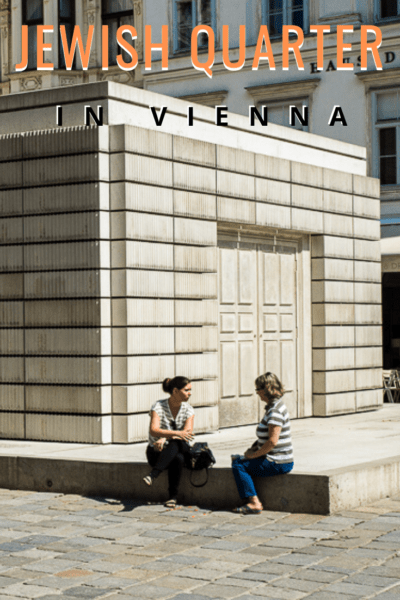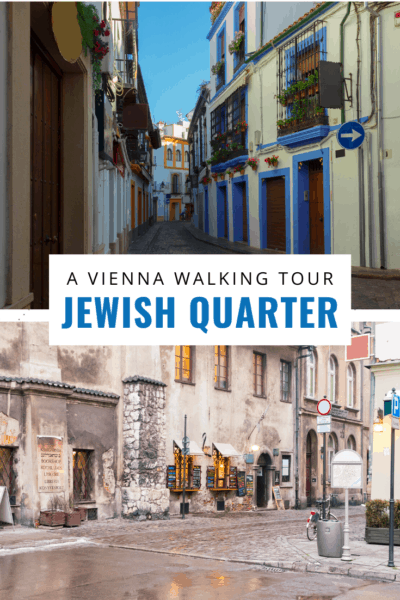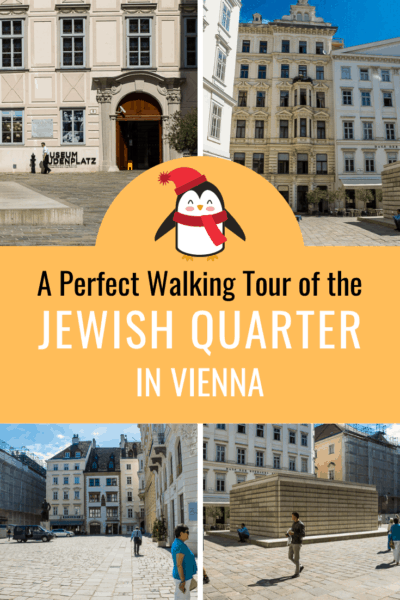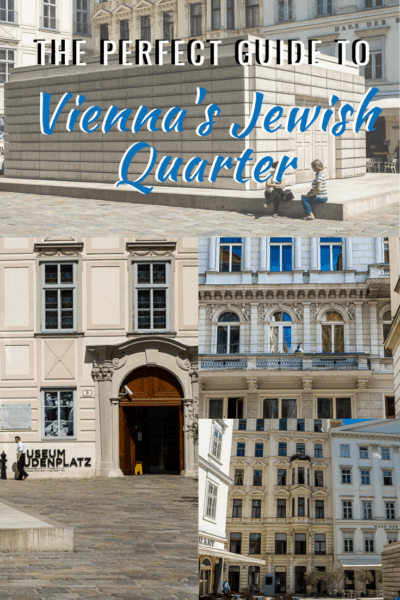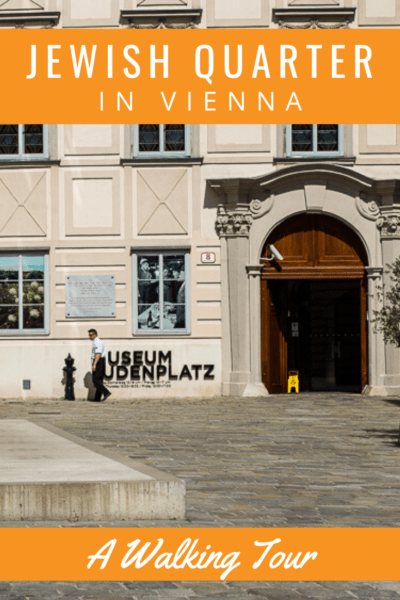Vienna, the enchanting capital of Austria, is renowned for its rich history, stunning architecture, and vibrant cultural scene. While many visitors flock to the city to immerse themselves in its world-class art and music, there is one aspect that often goes unnoticed but holds an extraordinary significance—the Jewish culture that has flourished within its borders for centuries.
If you’re into history or culture, the Jewish Quarter is an absolute must see. From its narrow cobblestone streets to its charming courtyards and architectural landmarks, the area offers a tangible connection to a bygone era. As you walk in the footsteps of those who came before, you’ll gain a deeper understanding of Vienna’s complex Jewish heritage and the indelible mark it has left on the city’s identity.
In this blog post, we’ll take you through Vienna’s Jewish Quarter—a captivating journey into the heart of the city’s Jewish history. Join us as we delve into the vibrant past, uncover architectural gems, and unravel the stories of triumph and tragedy that have shaped this remarkable neighborhood.
Things to see in the Jewish Quarter, Vienna tour
Leopoldstadt
Vienna’s Jewish Quarter, also known as Leopoldstadt, is a historically significant neighborhood steeped in centuries of culture and history. This captivating district, along the banks of the majestic Danube River, offers a remarkable tapestry of Jewish life and heritage waiting to be explored.
Starting in the Modern Jewish Quarter is this historic theater. Nestroyhof Jewish Theater was once the center of Jewish culture in Vienna, but was closed by the National Socialists in 1938.
It was reopened in 2003 for the citizens of Vienna to enjoy joyous performances once again. The theater is old, but has been restored to its former glory. Luckily for travelers, tickets to a show are reasonably priced so be sure to book if you have enough time.
Next, you should visit Leopoldstädter Temple, which was once the largest synagogue in Vienna. After being built in 1858, the temple was later destroyed during Kristallnacht in 1938. Now only four white columns and a plaque remain.
Kristallnacht is also known as the night of broken glass, as broken glass was lay shattered in the street after parliamentary carried out a violent riot against the Austrian Jews in 1938. Their shops, homes, buildings and synagogues were ransacked, burned and smashed. Jews were also assaulted and beaten.
In this area, you’ll see a lot of Stolpersteine in the pavement. A stolperstein, or stumbling block, is a 4″x4″ brass plaque that contains one or more names of Austrian victims that were exterminated or persecuted by the Nazis during World War II, the marker being placed in front of the building where the Holocaust victim was arrested. Although Stolpersteine are concentrated in this area, they can be found all over the city.
ⓘ TIP: When you’re ready to move on from the Modern Jewish Quarter, take the U-Bahn (U1) from Nestroyplatz to Schwedenplatz and continue on to Stadttempel. This will save you a kilometer’s walk (about 15 minutes).
Stadttempel
Serving as Vienna’s main synagogue, the Stadttempel is a significant landmark tucked away in the Innere Stadt district. Its unique location, hidden from direct street view, is due to a historical law that only allowed Roman Catholic Churches to be visible from the streets when it was built in 1826.
The synagogue holds a poignant place in history, especially during the harrowing events of Kristallnacht in 1938. This night saw Nazi paramilitary troops and local authorities take part in a systematic destruction of synagogues and Jewish prayer houses across Vienna. In the aftermath, out of the 93 Jewish places of worship, only the Stadttempel remained.
The synagogue’s architecture is as unique as its history. Built in an oval shape, it features a two-tier gallery supported by twelve pillars symbolizing the Twelve Tribes of Israel. Despite the passage of time and the trials it has endured, the Stadttempel has been meticulously maintained through three renovations, ensuring it remains as striking as it was when first built.
ⓘ TIP: Visiting the Stadttempel is a must-do activity while you’re in Vienna, but make sure you book before you go. Bookings can be made on their website prior to your visit.
Judenplatz Holocaust Memorial and Square
Judenplatz Square is just off Ledererhof road and makes for the perfect stop during your Jewish Quarter walking tour.
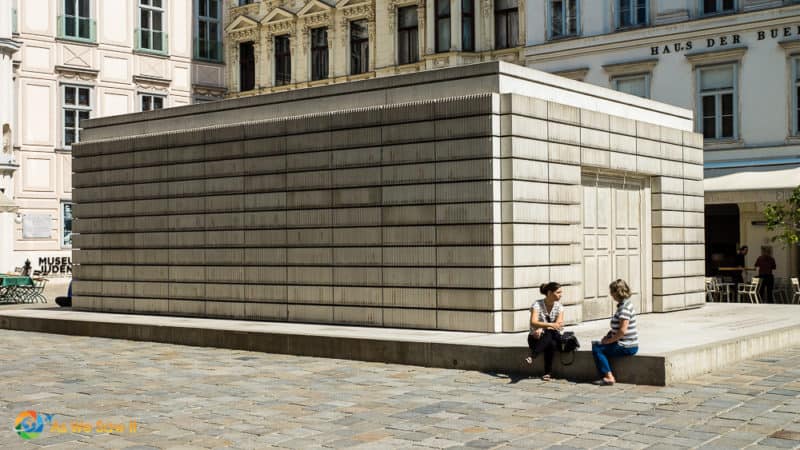
Judenplatz is comprised of two main parts, the Schulhof and the Southern part of the square which is referred to as Judenplatz. Here you’ll find a cobblestone square surrounded by hotels, boutiques, and restaurants.
In this part of the square, you’ll see a statue of Gotthold Ephraim Lessing, who was a German writer, dramatist, philosopher, publicist, and art critic during the 1700s.
The Judenplatz Holocaust Memorial is also known as the Nameless Library. It acts as a central memorial for all of the Austrian Holocaust victims. The memorial is made of steel and concrete, and the outside surface is library shelves that have been turned inside out.
The memorial has a striking contrast to other beautiful buildings in Vienna, as it is fairly plain. This was intended by the artist so that it would stand out from the other buildings.
Judenplatz Museum
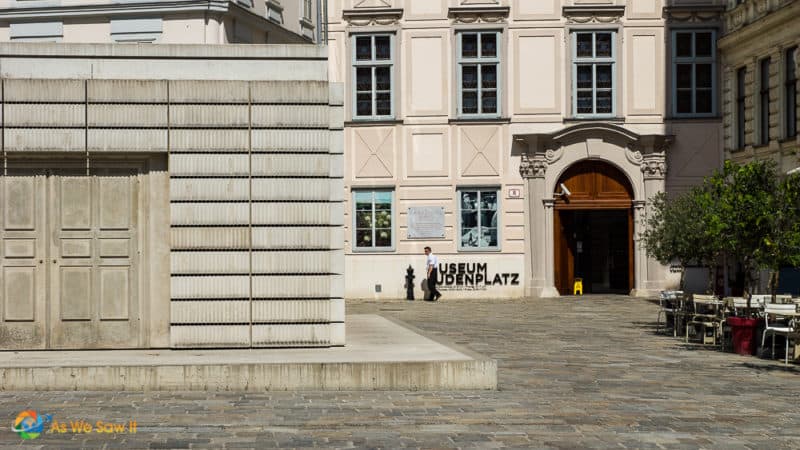
The Museum in Judenplatz Square is a must-visit on all Jewish Quarter walking tours. It overlooks Schulhof, so you’ll be able to find it easily from your last stop. It combines three things – Rachel Whiteread’s Memorial, the excavation of the medieval synagogue, and the museum of medieval jewelry.
Here, you’ll learn about the religious, cultural, and social living conditions of the Jews who lived in Vienna. Displays cover eras from the middle-ages through to their expulsion in 1421.
The Rachel Whiteread Memorial is of vital importance to the Jews of Vienna. Around the memorial, you’ll find tiles set into the ground that contain the names and places where Austrian Jews lost their lives during the Nazi period.
Ledererhof
You’ll then come to Ledererhof, a small street that gives you a more intimate look at the lives of those who live in the area. Small apartment blocks are built up around the road, shading it from the midday sun.
Schulhof
Continue to Schulhof, which is in the center of the Jewish Quarter.
Until 1421, Schulhof (Jewish schoolyard) was apart of Judenstadt, but after the violent expulsion of the Jews at this time, the area was left to the Carmelite Monastery to serve as their cemetery.
The area is now referred to as Judenplatz (Jewish Square) because it was once the very center of Jewish life in Vienna.
Kurrentgasse
Kurrentgasse is the next stop on your walking tour, which is a very narrow alleyway/road near Judenplatz Square.
The best thing to do on this street is to pop into Backerei Arthur Grimm, which is a bakery that makes all kinds of fresh bread and pastries. The wonderful smell emanating from the small shop is more than enough to entice you inside.
The bakery is well renowned around the area, so pick up a take away and enjoy a freshly baked patisserie during your walking tour of Vienna.
Steindgasse
Just a minute’s walk from Kurrentgasse, Steindgasse is a narrow alleyway lined with boutiques, luxury fashion brands, and high-end jewelry stores. You could spend the whole day window-shopping in this area, or make a special purchase to commemorate your trip to Vienna.
The alleyway is covered by a glass roof, which makes touring Vienna easy even when the weather is bad. It’s also divided by trees and plants in the center, making it the perfect picturesque scene to take a few photos.
Kleeblattgasse
Kleeblattgasse is another short walk from Steindgasse, and it’s a very vibrant part of the city. The street is wide and accommodates many buses every day. This street is also lined with fashion stores and other high-end retail.
There are many small alleyways leading off this road that are worth exploring. You might find a hidden gem clothing store or coffee shop that you wouldn’t have known about otherwise!
This entire walking tour should take you around 30-minutes, not counting the time you spend at each place.
Other places to visit during your free walking tour in Vienna
The places above all connect together making it a great route. However, if you’re looking for a few more places to visit in the area, these sites deserve a quick detour!
St Peter’s Catholic Church
St Peter’s Catholic Church is absolutely stunning. The architecture and design will knock you off your feet. Gold edgings finish off the church perfectly and beautiful old paintings take you back to the time they were painted. It’s not far from the other attractions we have mentioned, making it easily walkable.
Cafe Central
Although Cafe Central may sound like a quaint coffee house, it couldn’t be further from it. This traditional Viennese cafe was once frequented by the likes of Freud, Trotsky and other great minds of its time. It boasts amazing marble ceilings and other ornate decorations.
You can sit down to order Viennese cuisine, or sip on a variety of different coffees while mulling over the bigger questions in life – like those who visited before you.
Wrapping up our Vienna walking tour of the Jewish Quarter
We thoroughly enjoyed walking through the cobbled lanes and alleyways of Venice and we’re certain you will too! Feel as if you’ve stepped into a different century as you admire wonderful architecture and beautiful Vienna sightseeing attractions.
The Jewish Quarter is one that simply must be explored during your time in Vienna, along with a whole variety of other day trips from Vienna. Your Vienna walking tours await you!

